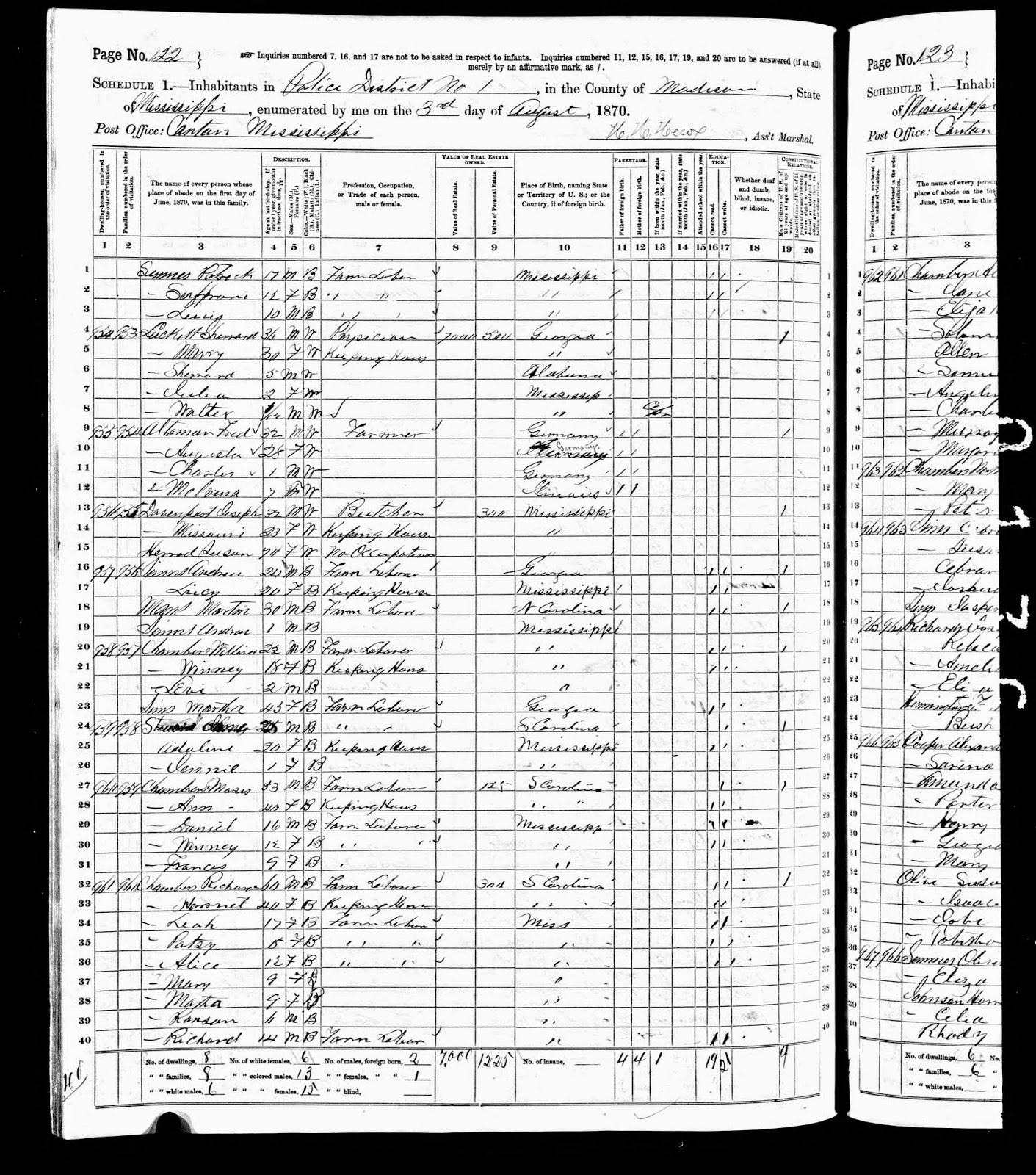According to her entry in the 1860 U.S. Census, Susan Herrod, nee Grubb, was born in Mississippi about 1805 because her age is given as 55. (However in the 1870 census she's listed as being 70 and 38 in the 1850 census so there's a choice available.)
[Ancestry.com. 1860 United States Federal Census [database on-line]. Provo, UT, USA: Ancestry.com Operations, Inc., 2009. Images reproduced by FamilySearch. Original data: 1860 U.S. census, population schedule. NARA microfilm publication M653, 1,438 rolls. Washington, D.C.: National Archives and Records]
If we have her parentage correct, her father was Benjamin Grubb* who moved west from Virginia in about 1790, settling first in Natchez and then moving on to Louisiana about seven years later where he remained for the rest of his life. As for her mother's name, there are at least two choices and a lot of uncertainty with either of them.
On September 8, 1822, my great great great grandfather Barnabas (or Barnett) Herrod married Susanna Grubb in Franklin County, Mississippi. The couple had at least seven children, of whom their daughter Celestine Letitia Herrod is my direct ancestor.
Although there are various court records of Barnabas owning land and acting as the administrator of several estates, there's no reason to believe that he was particularly successful. The 1850 U.S. Census shows this clearly as
Barnabas is an innkeeper with real estate worth $160 and his wife Susan owns $4,000 worth of property herself.
[Ancestry.com. 1850 United States Federal Census [database on-line]. Provo, UT, USA: Ancestry.com Operations, Inc., 2009. Images reproduced by FamilySearch. Original data: Seventh Census of the United States, 1850; (National Archives Microfilm Publication M432, 1009 rolls); Records of the Bureau of the Census, Record Group 29; National Archives, Washington, D.C.]
For a closer look at Susan's property, here's an 1849 Madison County tax list which shows that B. Herrod owes a total of $0.50 solely for his poll tax while his wife is taxed for a carriage, a clock and a slave under the age of 60 for a total of $1.25.
["Mississippi, State Archives, Various Records, 1820-1951," index and images, FamilySearch (https://familysearch.org/pal:/MM9.3.1/TH-1942-21381-45784-58?cc=1919687&wc=9B4Z-CXF:211900801,212009201 : accessed 16 December 2014), Madison > County tax rolls 1849, Box 3717 > image 18 of 39; Mississippi Department of Archvies and History, Jackson.]
A wife owning property separate from her husband is very unusual for this time, especially in a southern state like Mississippi. I wonder how that came about?
In the 1860 U.S. Census above, we can see that the widowed Susan Herrod and her youngest daughter Missouri are living in a hotel in Canton, Madison County, and there are no assets listed for her.
By 1870 she's still living in Canton but is living in the household of Joseph Davenport who was Missouri's husband. Susan is listed as having "no occupation" and no property.
[Ancestry.com. 1870 United States Federal Census [database on-line]. Provo, UT, USA: Ancestry.com Operations, Inc., 2009. Images reproduced by FamilySearch. Original data: 1870 U.S. census, population schedules. NARA microfilm publication M593, 1,761 rolls. Washington, D.C.: National Archives and Records Administration, n.d.Minnesota census schedules for 1870. NARA microfilm publication T132, 13 rolls. Washington, D.C.: National Archives and Records Administration, n.d]
And that's the last record we've been able to find for my three-time great grandmother.
*There are some
very interesting things to say about old Benjamin, who definitely deserves his own post and will get it someday.
© 2014 Copyright, Christine Manczuk, All Rights Reserved.






